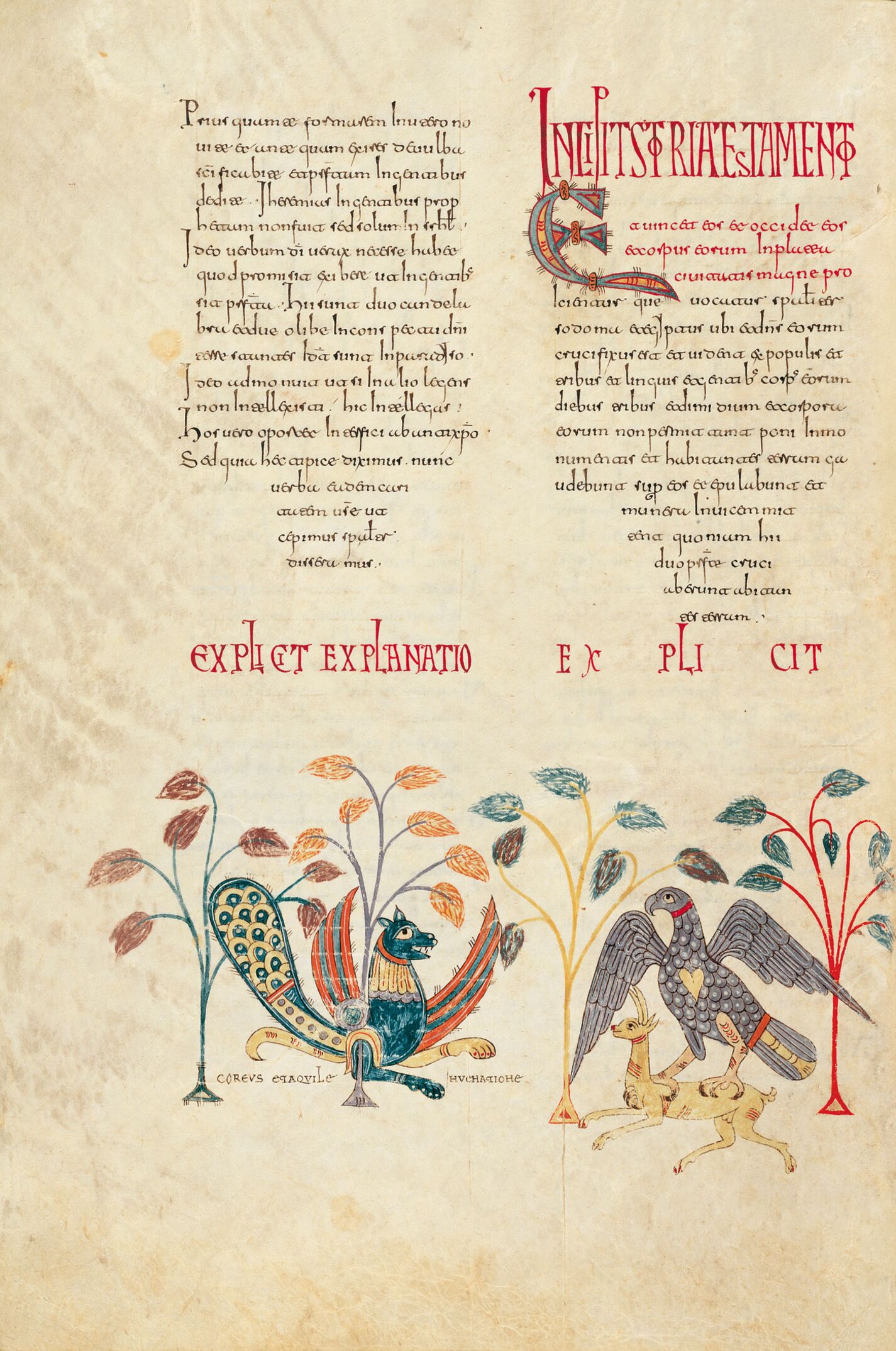Situated on the left between four highly schematic and decorative trees is a zoomorphic monster with a lion’s body, an eagle wings and a peacock’s tail, with the legend “COREVS ET AQVILE/IN VENATIONE” underneath. Next to this beast is an eagle with outspread wings, a red ring around its neck and the base of its tail and a heart shape upon its chest, seizing a gazelle in its claws. The source of these two animals lies in Persian art transmitted via Islamic art. The original meaning of this theme of Iranian mythology, representing the mythical battle between the two animals, has been lost in the Gerona Beatus which depicts the theme as a sort of imaginary hunting scene which has not, nevertheless, lost the sense of oriental wonder. The first monster is an ancient, eastern creature known as the senmurv or simurgh, appearing in Sassanian rock reliefs, in items worked in metal, ivory items and Islamic and Byzantine fabrics. The eagle seizing the gazelle also appears in Andalusian reliefs along with griffons. The eagle-Coreus combination can be seen in a mosaic in the ninth-century flooring of the former Sant’Ilario abbey in Venice, and often appeared in the decoration of tenth-century manuscripts from southern Italy. Hunting animals of this type are very common in Islamic items worked in marble and ivory. Silk fabrics served as models for such marble articles in the Omeya workshops of Andalusia. Furthermore, there is evidence of the sale of Byzantine fabrics in León since the 10th century – although it is sometimes difficult to differentiate Andalusian from Byzantine items. There is nothing to show that these topics appeared in Muslim manuscripts belonging to the same period as the Gerona Beatus. This illustration does however demonstrate that most Islamic borrowings are obviously to be found outside the Apocalyptic cycle, in marginal areas. The Gerona Beatus features the widest range of subjects adapted from Islamic contexts due, inter alia, to its large size and the large amount of parchment available. Despite Gerona being the only one in the Beatus series to feature it, the representation of Coreus, or simurg in its eastern form, did appear early on in north-western, Hispanic kingdoms, as can be seen in the tapestry page in the Bible of 920 (León, Colegiata de San Isidoro, Cod. 6, f. 3v), and it also featured in the Hispanic art of the late Middle Ages, which employed formulae closer to Byzantine and Sassanian models.
Carlos Miranda García-Tejedor
Doctor in History
(Fragment of the Girona Beatus commentary volume)

Situated on the left between four highly schematic and decorative trees is a zoomorphic monster with a lion’s body, an eagle wings and a peacock’s tail, with the legend “COREVS ET AQVILE/IN VENATIONE” underneath. Next to this beast is an eagle with outspread wings, a red ring around its neck and the base of its tail and a heart shape upon its chest, seizing a gazelle in its claws. The source of these two animals lies in Persian art transmitted via Islamic art. The original meaning of this theme of Iranian mythology, representing the mythical battle between the two animals, has been lost in the Gerona Beatus which depicts the theme as a sort of imaginary hunting scene which has not, nevertheless, lost the sense of oriental wonder. The first monster is an ancient, eastern creature known as the senmurv or simurgh, appearing in Sassanian rock reliefs, in items worked in metal, ivory items and Islamic and Byzantine fabrics. The eagle seizing the gazelle also appears in Andalusian reliefs along with griffons. The eagle-Coreus combination can be seen in a mosaic in the ninth-century flooring of the former Sant’Ilario abbey in Venice, and often appeared in the decoration of tenth-century manuscripts from southern Italy. Hunting animals of this type are very common in Islamic items worked in marble and ivory. Silk fabrics served as models for such marble articles in the Omeya workshops of Andalusia. Furthermore, there is evidence of the sale of Byzantine fabrics in León since the 10th century – although it is sometimes difficult to differentiate Andalusian from Byzantine items. There is nothing to show that these topics appeared in Muslim manuscripts belonging to the same period as the Gerona Beatus. This illustration does however demonstrate that most Islamic borrowings are obviously to be found outside the Apocalyptic cycle, in marginal areas. The Gerona Beatus features the widest range of subjects adapted from Islamic contexts due, inter alia, to its large size and the large amount of parchment available. Despite Gerona being the only one in the Beatus series to feature it, the representation of Coreus, or simurg in its eastern form, did appear early on in north-western, Hispanic kingdoms, as can be seen in the tapestry page in the Bible of 920 (León, Colegiata de San Isidoro, Cod. 6, f. 3v), and it also featured in the Hispanic art of the late Middle Ages, which employed formulae closer to Byzantine and Sassanian models.
Carlos Miranda García-Tejedor
Doctor in History
(Fragment of the Girona Beatus commentary volume)